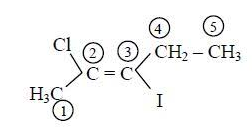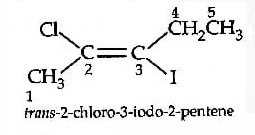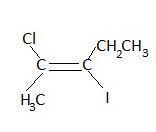
Answer
445.8k+ views
Hint: IUPAC has certain set rules for the naming of chemical compounds. This ensures that no two compounds will have the same nomenclature. We first need to find the long chain, assign numbers to the carbons, taking into consideration the substituents and the double bond. For cis and trans, we need to apply CIP rules.
Complete step by step answer:
Given: The structure of a compound (a substituted alkene) is given.
Steps:
To assign a name to the compound given above, the following steps should be done:
1. First, we select the longest hydrocarbon chain. Here it is a five carbon chain with a double bond. So, it’s a pentene (-ene suffix for alkenes).
2. Then, based on the fact that the substituents and double bonds need to be assigned as low a number as possible, when we assign the numbers for C atoms, we try to do it from the right hand side first. Then, it is assigned 3 for Iodine, 3 for double bond and 4 for Chlorine.
3. Assigning from the left hand side, we get the number 2, 2 and 3 for Chlorine, double bond and Iodine respectively.
4. Thus, we assign numbering from the left hand side as the double bond gets the lowest number along with the other substituents. This is known as the lowest set of locants rules. The numbers represent locants/location of a group on the carbon chain. The locant set (2,2,3) is the lowest set that can be assigned when numbered from the left hand side.

5. Next, to assign cis or trans to the compound, we need to look at the upper and lower groups assigned to the double bond.
6. On the right hand side, we have an ethyl group on the upper side and an iodine group to the lower side. Using the CIP rule, we can assign priorities to the two groups. We need to look at the atomic number of the directly attached atom first. If it's the same, then we consider the atomic weight. Here, Iodine is assigned 1 and Carbon 2.
7. Similarly, for the left hand side, chlorine is assigned 1 and methyl group 2.
8. The number (priority) 1 is downward while the other is upward. Similarly, the number 2 is downward on one side and oppositely placed on the other. Thus, the compound is a trans compound.
9. Thus, considering all these observations, the nomenclature of the compound comes to be:
Trans-2-chloro-3-iodo-2-pentene.

Thus, the correct option is (a).
Note:
While naming the compound, we write the different substituents alphabetically, so chloro followed by iodo. Also, as seen above the double bond must get the lowest number possible.IUPAC and CIP rules should be thoroughly studied by the students.
Complete step by step answer:
Given: The structure of a compound (a substituted alkene) is given.
Steps:
To assign a name to the compound given above, the following steps should be done:
1. First, we select the longest hydrocarbon chain. Here it is a five carbon chain with a double bond. So, it’s a pentene (-ene suffix for alkenes).
2. Then, based on the fact that the substituents and double bonds need to be assigned as low a number as possible, when we assign the numbers for C atoms, we try to do it from the right hand side first. Then, it is assigned 3 for Iodine, 3 for double bond and 4 for Chlorine.
3. Assigning from the left hand side, we get the number 2, 2 and 3 for Chlorine, double bond and Iodine respectively.
4. Thus, we assign numbering from the left hand side as the double bond gets the lowest number along with the other substituents. This is known as the lowest set of locants rules. The numbers represent locants/location of a group on the carbon chain. The locant set (2,2,3) is the lowest set that can be assigned when numbered from the left hand side.

5. Next, to assign cis or trans to the compound, we need to look at the upper and lower groups assigned to the double bond.
6. On the right hand side, we have an ethyl group on the upper side and an iodine group to the lower side. Using the CIP rule, we can assign priorities to the two groups. We need to look at the atomic number of the directly attached atom first. If it's the same, then we consider the atomic weight. Here, Iodine is assigned 1 and Carbon 2.
7. Similarly, for the left hand side, chlorine is assigned 1 and methyl group 2.
8. The number (priority) 1 is downward while the other is upward. Similarly, the number 2 is downward on one side and oppositely placed on the other. Thus, the compound is a trans compound.
9. Thus, considering all these observations, the nomenclature of the compound comes to be:
Trans-2-chloro-3-iodo-2-pentene.

Thus, the correct option is (a).
Note:
While naming the compound, we write the different substituents alphabetically, so chloro followed by iodo. Also, as seen above the double bond must get the lowest number possible.IUPAC and CIP rules should be thoroughly studied by the students.
Recently Updated Pages
what is the correct chronological order of the following class 10 social science CBSE

Which of the following was not the actual cause for class 10 social science CBSE

Which of the following statements is not correct A class 10 social science CBSE

Which of the following leaders was not present in the class 10 social science CBSE

Garampani Sanctuary is located at A Diphu Assam B Gangtok class 10 social science CBSE

Which one of the following places is not covered by class 10 social science CBSE

Trending doubts
Which are the Top 10 Largest Countries of the World?

How do you graph the function fx 4x class 9 maths CBSE

Fill the blanks with the suitable prepositions 1 The class 9 english CBSE

The only snake that builds a nest is a Krait b King class 11 biology CBSE

The Equation xxx + 2 is Satisfied when x is Equal to Class 10 Maths

In Indian rupees 1 trillion is equal to how many c class 8 maths CBSE

Give 10 examples for herbs , shrubs , climbers , creepers

Why is there a time difference of about 5 hours between class 10 social science CBSE

Which places in India experience sunrise first and class 9 social science CBSE




